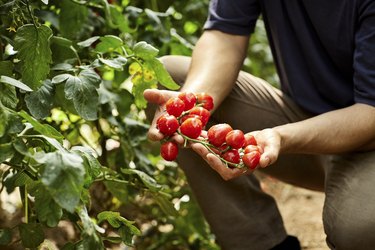
Things You'll Need
Nitrile or latex gloves
Quart-sized jar
Bleach
Distilled water
Murashige and Skoog (MS) medium in single-use packets
Sugar
Benzlaminopurine (BAP)
Plant Preservative Mixture (PPM)
Baking soda
Vinegar
pH papers
Tablespoon
4-ounce jars (20)
Microwave oven
Agar powder
Rubber bands (20)
Plastic wrap
Sterile razor blade or utility knife
Rubbing alcohol
Spray bottle
Medium glass jar
Sterile tweezers
Small plate
For the avid gardener, knowing how to propagate plants at home, through tissue culture, can save a lot of money. It makes no difference if you want to replicate many plants from a single favorite or if you prefer to collect specimens at a local park to bring home and regrow for some garden variety. The basic setup for tissue culture plants at home can be easily created in your own kitchen. With basic knowledge of plant tissue culture techniques, there's no need to purchase plants ever again.
Step 1: Prepare the Work Area for Tissue Culture at Home
Put on a pair of nitrile or latex gloves. Fill a spray bottle three-quarters full with rubbing alcohol and top it off with distilled water. Spray the counter on which you plan to work. Also spray your gloves and allow them to air-dry.
Video of the Day
Step 2: Sterilize a Jar
Soak a quart-sized jar in 10 percent bleach for 10 minutes then rinse it well in distilled water.
Step 3: Prepare the Growing Medium
Prepare the plant medium in the sterile jar. Combine one packet of MS medium, 2 tablespoons of sugar, 1 mg BAP, 1 ml PPM and 1/2-quart of distilled water. Check the pH of the solution with pH papers. Adjust the pH to between 5.5 and 6.0, using baking soda to bring the pH up or vinegar to bring it down. Add distilled water until the container reaches the full level.
Step 4: Fill the Jars With Medium
Add 3 tablespoons of the prepared medium to each 4-ounce jar, for a total of 20 jars. Add a pinch of agar to each jar.
Step 5: Cover the Jars With Plastic
Cover each of the jars in plastic wrap, seal them with rubber bands then poke ventilation holes in the plastic wrap with a sterile razor blade or utility knife.
Step 6: Dissolve the Agar
Microwave the jars for one minute then swirl the contents of each jar gently to ensure the agar powder is fully dissolved and has mixed with the prepared medium. If the contents aren't homogeneous, microwave them again in 30-second bursts until the agar powder has dissolved.
Step 7: Sterilize the Plant Material
Fill a medium glass jar with 10 percent bleach. After spraying your plant material with 70 percent rubbing alcohol and rinsing it in distilled water, soak the plant material in the jar of 10 percent bleach for 10 minutes.
Step 8: Soak the Plant Material
Discard the bleach solution and, with the same jar, let the plant material soak in distilled water for five minutes. Change the water after one minute and again after three minutes to ensure the bleach is rinsed away.
Step 9: Cut the Plant Material
Rinse a small plate with 70 percent rubbing alcohol and allow it to air-dry. Move the plant material from the water rinse to the sterile plate with sterile tweezers then cut the plant material into small pieces with the tweezers and the sterile razor blade or utility knife.
Step 10: Add Plant Material to the Agar
Place a piece of plant material in each of the small jars with the agar plant medium.
Step 11: Give the Jars Adequate Lighting
Leave the jars in a greenhouse or under a growth light for 16 hours each day. After four to five weeks, small shoots will sprout from the plant material you started by plant tissue culture. These small plants can be transferred to growth discs, vitamin-rich soil or a second growth medium in agar before being replanted in pots or in the garden.
Tip
Lots of different plants are good specimens for folks just beginning to experiment with cloning, or tissue culture at home. Excellent subjects include cauliflower florets, African violet leaves, carnation stems and rose cuttings.
Always use sterilized tools to collect plant material for use in tissue culture.
Warning
Although PPM is a biocide and helps prevent contamination growth, the conditions in the agar plant medium are created for plants to grow easily. If you notice unwelcome growth or contamination, replant the shoots in fresh, uncontaminated containers of agar plant medium.
Video of the Day